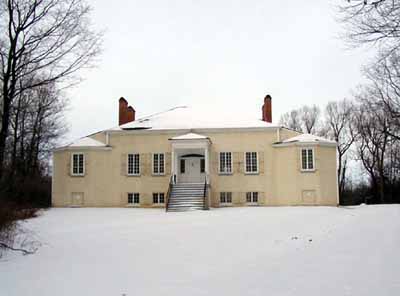Inverarden House National Historic Site of Canada
Cornwall, Ontario

General view
© Parks Canada Agency / Agence Parcs Canada
Address :
Just east of 3330 Montreal Rd., Cornwall, Ontario
Recognition Statute:
Historic Sites and Monuments Act (R.S.C., 1985, c. H-4)
Designation Date:
1968-06-19
Dates:
-
1816 to 1823
(Construction)
-
1816 to 1823
(Significant)
Event, Person, Organization:
-
John McDonald of Garth
(Person)
Other Name(s):
-
Inverarden House
(Designation Name)
Research Report Number:
1968-32; 1968-07
DFRP Number:
56477 00
Plaque(s)
Unknown: Mounted on rock on north side of Montreal Rd. (Hwy. 2) just east of entrance to Inverarden House NHS Just east of 3330 Montreal Rd., Cornwall, Ontario
This House, built in 1816, is a fine early example of Regency architecture and its interior is a pleasing expression of Georgian symmetry with excellent detailing. In a wooded setting and commanding and impressive view, this was a fitting home for a country squire. It was built for retired fur trader John McDonald of Garth, an aggressive and successful North West Company wintering partner during the rivalry with the Hudson's Bay Company. In 1824 McDonald gave the house to a daughter, wife of retired fur trader John Duncan Campbell, and it remained in the Campbell family until 1965.
Description of Historic Place
Inverarden House National Historic Site of Canada is a gracious early nineteenth century house set on a 1 hectare fragment of the original estate of John McDonald of Garth on the north side of County Road 2 (formerly Highway 2) along the St. Lawrence River on the outskirts of Cornwall.
Heritage Value
Inverarden House was declared a National Historic Site in 1968 in recognition of its historic and architectural significance as defined in its 1977 plaque inscription: it is a fine early example of Regency architecture, a fitting home for a country squire, it was built for retired Northwest Company fur trader John McDonald of Garth.
The heritage value of this site resides in its physical illustration of domestic Regency architecture and in its association with Northwest Company fur trader John McDonald of Garth.
Inverarden House epitomizes the taste and social standing of retired Northwest Company fur traders who settled in this part of Ontario in the 19th century. John McDonald of Garth built the central portion of Inverarden House in 1816 and added its wings (1821-1823), completing a substantial Regency residence.
Source: HSMBC Minutes, 1968.
Character-Defining Elements
Key elements that contribute to the heritage character of the site include its: the rectangular massing of the single storey main block with balanced subsidiary wings set high on a foundation the truncated hipped roof with balanced chimneys, the symmetrical, five-bay organization of the facade organized central entry the wooden entry door with sidelights and elliptical fanlight the regular placement of casement windows and wing apertures (vertically in bays, horizontally in openings of a similar size), Georgian-era exterior detailing, including casement windows, chimney pots, shutters, and classically inspired window and door surrounds, stone and stucco exterior walls, the spacious, symmetrical volumes of the interior with its central hall design, large rooms, high ceilings, the surviving original features of the interior including decorative plasterwork, staircase, fireplaces, hardware, woodwork, recessed elliptical arch with flanking doors in the dining room, the original hearth, smoke cupboard and bake oven in the kitchen, the building's prominent site high on a natural rise above the St. Lawrence River in a picturesque wooded setting, the house's inter-relationship with long term elements of its picturesque setting (its views from the house to the river, and its relationship to the original approach road).